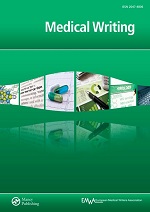
Volume 22, Issue 1 - Medical Writing Education
Teaching scientific writing using the learner-centred approach
Author: Felicity Neilson
Abstract
Learner-centred teaching is particularly suited to the teaching of scientific writing. The underlying premise of the learner-centred approach is simple: the learner will better assimilate new information if it is built on what they already ‘know’ than if it is imposed from the outside as in a teacher-centred approach. This approach goes step by step, progressively integrating new knowledge without artificially bending the course of the session to fit into preconceived content. The learner-centred approach has enormous advantages for the trainer: it is highly gratifying to stay focused on a group's needs, learn to listen to individuals, share the learning experience, and follow the trainees’ progress. At the end of the session, very often groups go home with a deep, relevant training experience that ‘speaks’ to them, is immediately applicable, and is therefore likely to stay firmly anchored.
 Download the full article
Download the full article
References
- Dewey J. My pedagogic creed. School J 1897;54:77–80.
- Dewey J. Experience and Education. Kappa Delta Pi lecture series. New York: Macmillan; 1938
- Rogers C. Freedom to learn: a view of what education might become. Columbus, Ohio: Charles E. Merrill Publishing Company; 1969.
- Rogers C. Client-centered therapy: its current practice, implications and theory. London: Constable; 1951.
- Lombardo M, Eichinger R. The career architect development planner. 1st ed. Minneapolis: Lominger; 1996. pp. iv.
- Kirschenbaum H, Henderson VL, (eds.). The carl rogers reader. Boston: Houghton Mifflin; 1989. pp. 6–28.
Search
Articles
Links
Editoral Board
Editor-in-Chief
Co-Editors
Managing Editor
Victoria White
Associate Editors
Section Editors
AI/Automation
Biotechnology
Digital Communication
EMWA News
Gained in Translation
Getting Your Foot in the Door
Good Writing Practice
In the Bookstores
Publications
Medical Communications/Writing for Patients
Medical Devices
My First Medical Writing
News from the EMA
Freelancing
Pharmacovigilance
Regulatory Matters
Regulatory Public Disclosure
Teaching Medical Writing
Louisa Ludwig-Begall / Sarah Kabani
The Crofter: Sustainable Communications
Veterinary Writing
Editors Emeritus
Layout Designer
Chris Monk
 Visit the EMWA website
Visit the EMWA website